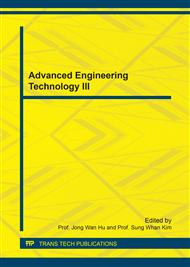[1]
B. Siciliano, O. Khatib, Handbooks of robotics. Springer, (2008).
Google Scholar
[2]
K. Fu, R. Gonzalez, C. Lee, Robotics: Control, Sensing, Vision, and Intelligence, Mcgraw-Hill Book Company, (1987).
Google Scholar
[3]
T. I. Fossen, Handbook of Marine Craft Hydrodynamics and Motion Control, Wiey & Sons Ltd., (2011).
Google Scholar
[4]
I. E. Tuphanov, A. F. Scherbatyuk, Adaptive algorithm of AUV meander pattern trajectory planning for underwater sampling, In Proceedings of the 10th ISOPE Pacific/Asia Offshore Mechanics Symposium, Vladivostok, Russia, (2012), p.181 – 185.
Google Scholar
[5]
A. V. Lebedev, The formation of dynamic objects trajectories in conditions of control signals saturation, In Proc. of the 18th World Multi-Conference on Systemics, Cybernetics and Informatics, Orlando, USA, (1) (2014) 154-159.
Google Scholar
[6]
V. Munoz, Smooth trajectory planning method for mobile robots, Special issue on Intelligent Autonomous Vehicles of the Journal of Integrated Computed-Aided Engineering, 6(4) (1999) 1-6.
Google Scholar
[7]
K. Yang, Continuous curvature path-smoothing algorithm using cubic Bézier spiral curves for non-holonomic robots, Adv. Robot. 27(4) (2013) 247-258.
DOI: 10.1080/01691864.2013.755246
Google Scholar
[8]
V. Filaretov, D. Yukhimets, E. Mursalimov, A. Scherbatyuk, I. Tuphanov, Some marine trial results of a new method for AUV trajectory motion control, In Proc. of 2014 OCEANS, St. John's, OCEANS 2014. St. John's, NL, Canada, (2014), pp.1-6.
DOI: 10.1109/oceans.2014.7003191
Google Scholar
[9]
V. Filaretov, A. Gubankov, I. Gornostaev, The Formation of Motion Laws for Mechatronics Objects Along the Paths with the Desired Speed, In. Proc. of Int. conf. on Computer, Control, Informatics and its Applications, Jacarta, Indonesia, (2016).
DOI: 10.1109/ic3ina.2016.7863030
Google Scholar
[10]
E. Ikonen, K. Najim, Advances process identification and control, Marcel Dekker Inc., (2002).
Google Scholar
[11]
C. De Boor, A practical guide to splines, Springer, (2001).
Google Scholar
[12]
Ph. Korn, M. Korn, Mathematical Handbook for scientists and engineers, MsGrow-Hill Book Co., (1968).
Google Scholar


